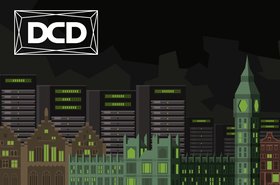Climate change is everywhere. In our newspapers, on our TV screens, and reflected in the extreme weather many of us are experiencing.
The fact is that the data center industry is responsible for about two percent of the world’s energy consumption, but this is only going to grow. With this comes even greater responsibility. To continue to profit off the demand, a more sustainable approach must be found.
“We've seen devices get smarter, activities get smarter, and this is driving an uplift in the server compute demands,” Nigel Gore, Senior Offering Manager at Vertiv, told the audience at DCD Europe last week.
“We are seeing faster and higher performance computing being evolved in reaction to these new demands for high-performance applications. It’s being driven in a number of different walks of life, we're seeing it in industrial automation, banking, digital health, gaming, and entertainment.
“As these devices increase in performance, they're using more powerful chips, and they become denser and that has implications for the data center,” Gore added. Companies like Vertiv have long recognised this and invested in research and development into solutions such as liquid cooling and heat recovery systems to make the data center more sustainable..
Gore was speaking on the panel “How is the climate imperative stimulating innovation?” along with Dr Jon Summers, the Scientific Lead in Data Centres at Research Institutes of Sweden, and Max Schulze, the Executive Chairman of the Sustainable Digital Infrastructure Alliance.
The issue is that, while inside the data center industry there is this awareness, the general public isn’t necessarily quite as clued up, suggested Summers.
“If you put all your IT on a cloud platform, to then talk about your sustainability, you need to know what's happening in the cloud. At the moment, there's no way to know what your environmental footprint is because you don't know what cooling technology they're using, you do not know what energy source they're using; whether it's renewable energy, or whether it's coming from coal.
“There needs to be a discussion going on, a good connection between the cloud provider who's running these services and the end-user. Just like you know how strong your Wi-Fi signal is, you need something that tells you how much CO2 [you generate] or how impactful you are on the environment using this particular service.”
But is this transparency too much to ask? The short answer is, ‘no, it shouldn’t be.’
In the current crisis, there should be a right to know more about the services you are using and their environmental impact. But that might take some form of regulation to make that a reality, as well as having the information provided in a form that makes comparisons between providers as straightforward as possible.
We don’t yet have full transparency, but progress is being made across the industry. Schulze has seen a number of steps already being taken.
“I have seen three past predictions that have come into reality. One is that CEOs are looking at the carbon footprint of the IT infrastructure. Organizations from around the world are asking us how they actually measure the CO2 footprint of their data centers and servers.
“The second is that regulators across these other markets are demanding to know how many data centers there are. What is their power consumption? What's their footprint? There is a huge increase in demand for transparency.
“The third prediction is the reporting. There's the Climate Neutral Data Center pact and some other initiatives making people think about how we can get this transparency in place. That includes data about heat recovery and actual densities.”
As pressure towards transparency increases, pressure to improve sustainable practices will soon follow. The industry can wait for regulations to demand a no-secrets policy, or it can act preemptively, improve its footprint and scream it from the rooftops.
I suggest the latter. After all, no one will enjoy being named and shamed for polluting – much better to lead by a good example.
More...
-

Understanding Data Center Liquid Cooling Options and Infrastructure Requirements
Take a deep-dive with content partner, Vertiv, on liquid cooling options for your data center
-

Small Cooling Systems: Assessing the Options for Edge Data Centers
With the need for dedicated cooling strategies ever present, content partner Vertiv take a look at the opportunities at the Edge
-

Addressing Common Misconceptions Surrounding Lithium-Ion Battery Recycling
A whitepaper exploring the methods for recycling used Lithium-Ion batteries


